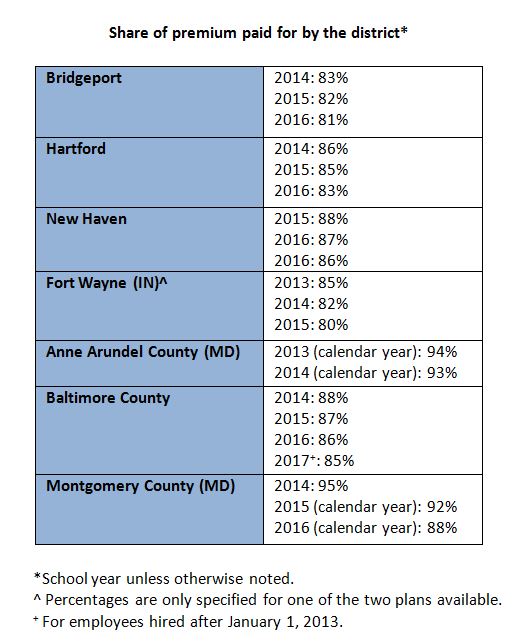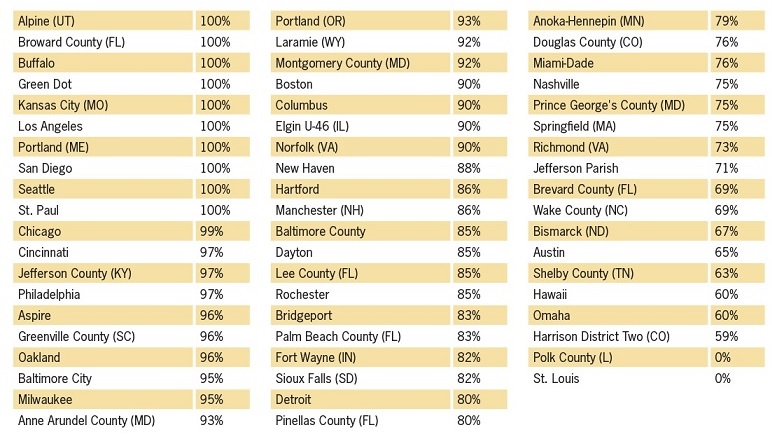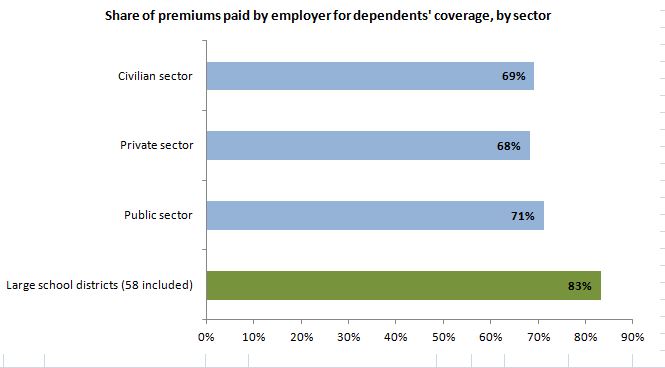District Trendline, previously known as Teacher Trendline, provides actionable research to improve district personnel policies that will strengthen the teacher workforce. Want evidence-based guidance on policies and practices that will enhance your ability to recruit, develop, and retain great teachers delivered right to your inbox each month? Subscribe here.
With health insurance
coverage making headlines in both national and
local news,
this month’s Trendline examines health insurance premiums for teachers and their dependents in the largest
districts across the country.
Coverage of teachers’ health insurance premiums
In our database of 118 traditional school
districts, there are 72 which specify the maximum portion that a district must
pay towards employees’ health insurance premiums: most (71 percent) pay at
least 90 percent of the full premium. About half (49 percent) pay all of it.

Not included above are two
districts—Anchorage
and Little
Rock— that define a dollar cap rather than a percentage maximum for employee’s
premium coverage. Anchorage offers a
maximum of $1,540 per month for its employees; in Little Rock, the district offers $358 per month. While these dollar
caps seem very far apart, both seem to be fairly generous
and we suspect the difference in amount has something to do with the cost of
living in these two cities.
Additionally, just as we observed two years ago,
districts cover a much higher portion of their employees’ health insurance
premiums relative to all other sectors. According to the Bureau of Labor
Statistics (see Table 3),
last year employers in the civilian, private and public sectors covered 81
percent, 79 percent and 87 percent of their employees’ health insurance
premiums, respectively. On average, the districts above cover 93 percent.
A couple of these districts have
interesting incentives for healthy behavior within their health insurance
coverage policies. Greenville
County (SC) pays for 97 percent of their employees’ premiums, but smokers
are required to pay an additional $40-$60 per month. In Jefferson
County (KY), 100 percent of employees’ premiums are covered unless the
employee is a smoker, in which case only 95 percent of the premium is covered.
In grappling with escalating costs, districts in
Connecticut, Maryland and Indiana have phased in lowered contributions
each year of the district’s collective bargaining contract term.

Coverage of dependents
Fewer districts in the
Teacher Contract Database specify how much they will pay towards dependents’
health insurance premiums. For the 57 districts that do not specify coverage
for employees’ dependents (out of 118), we left them out of this analysis
rather than assuming they do not cover dependents at all (as there may well be
separate memoranda addressing their policies).
Not surprisingly, of the
districts that do list a specific percentage for dependents’ coverage in the
teacher contract, fewer are apt to cover at least 90 percent of the premium
than cover the employee’s premium (47 percent versus 71 percent cited above). Only
two districts specify in their contracts that employees’ dependents’ premiums
are not covered at all by the district—Polk
County (FL) and St.
Louis; both districts do,
however, cover 100 percent of their
employees’ premiums.
Here are the numbers, district-by-district:
What is the maximum portion of employees’ dependents’ health insurance premium paid by the employer?

Not
included in the breakdown above are another five districts that put monetary
caps on dependents’ premium coverage. Anchorage,
Aldine
(TX) and Little Rock offer a
monthly coverage of $1,540, $330 and $358 per month, respectively. Minneapolis
offers $3,850 annually for dependents’ coverage while Indianapolis
offers a maximum of $8,445 to $12,142 depending on the employee’s selected
plan.
Excluding
the five districts which set a monetary cap on coverage for dependents’
premiums and the 52 districts where we cannot find language on this issue, we
find that the 58 districts in our database, on average, cover 83 percent of
their employees’ dependents’ health insurance premiums.
While
this may seem much lower compared to the average 93 percent premium coverage
offered by districts for employees, this rate is again relatively high when
compared to other sectors. The Bureau of Labor Statistics (see Table 4) reports that the
when it comes to employer’s coverage for families, the civilian sector covered
69 percent, the private sector covered 68 percent and the public sector covered
71 percent.
Again, districts in our database come out
looking generous in this comparison.

More like this

Does paid parental leave for teachers pay off?

The data and analyses district leaders used to support their work in 2024

Myth-busted: Teachers don’t skip school

